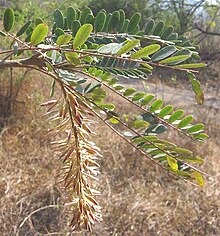| Picramniaceae | |
|---|---|

| |
| Alvaradoa amorphoides | |
| Scientific classification | |
| Kingdom: | Plantae |
| Clade: | Tracheophytes |
| Clade: | Angiosperms |
| Clade: | Eudicots |
| Clade: | Rosids |
| Order: | Picramniales Doweld |
| Family: | Picramniaceae Fernando & Quinn |
| Genera | |
| |
Picramniaceae is a small, mainly neotropical family of four genera Aenigmanu, Alvaradoa, Nothotalisia and Picramnia. The family is the only member of the order Picramniales. Members of the family were formerly placed in the family Simaroubaceae or misidentified as species in the family Sapindaceae, in the order Sapindales. The most recent standard classification of the Angiosperms (the APG III system) distinguishes it as a separate family and order. It belongs to the malvids (eurosids II), one of the three groups that constitute the rosids.
Four genera are accepted:
- Aenigmanu W.W.Thomas – 1 species, Peru and northwestern Brazil
- Alvaradoa Liebm. – 6 species, Mexico and Florida to central South America
- Nothotalisia W.W.Thomas – 3 species, Panama to Bolivia and northern Brazil
- Picramnia Sw. – 44 species, Mexico and Florida to northeastern Argentina
In 2021, a new genus was identified from materials collected almost 50 years prior. It was discovered by Robert Foster in 1973, but no scientist was able to identify it. It is named Aenigmanu for the enigma it originally presented to researchers.
Characteristics
The occurrence of tariric acid as the major fatty acid is typical for the Picramniaceae.
References
- ^ Angiosperm Phylogeny Group (2009). "An update of the Angiosperm Phylogeny Group classification for the orders and families of flowering plants: APG III". Botanical Journal of the Linnean Society. 161 (2): 105–121. doi:10.1111/j.1095-8339.2009.00996.x. hdl:10654/18083.
- ^ Picramniaceae Fernando & Quinn. Plants of the World Online. Retrieved 18 April 2024.
- Thomas WW (2011). Nothotalisia, a new genus of Picramniaceae from tropical America. Brittonia 63:51–61
- Barillas, Martin M. (2021-10-06). "'Mystery Plant' Finally Declared A New Species Decades After Its Discovery". Zenger News. Retrieved 2021-10-07.
- "Mystery plant" from the Amazon declared a new species after nearly 50 years of flummoxing scientists". eurekalert. 6 October 2021. Retrieved 6 October 2021.
- R. Hänsel, 22. Lipide in: R. Hänsel, O. Sticher (Hrsg.) Pharmakognosie Phytopharmazie 9. Auflage (2010) 673–674 Springer, Heidelberg ISBN 978-3-642-00962-4 (Google Books)
External links
- Picramniales (at Angiosperm Phylogeny Website)
- (“Mystery plant” from the Amazon declared a new species after nearly 50 years of flummoxing scientists)
| Orders of flowering plants (APG IV) | ||||||||||||||||||||||||||||||||||||||||||||||||||
|---|---|---|---|---|---|---|---|---|---|---|---|---|---|---|---|---|---|---|---|---|---|---|---|---|---|---|---|---|---|---|---|---|---|---|---|---|---|---|---|---|---|---|---|---|---|---|---|---|---|---|
| Angiosperms |
|  | ||||||||||||||||||||||||||||||||||||||||||||||||
| Taxon identifiers | |
|---|---|
| Picramniaceae |
|